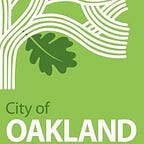The Next Change for Telegraph: Better Bus Boarding
(This post is the fourth in a series about the Telegraph Avenue ‘complete streets’ project. The project includes a road diet to calm traffic, parking-protected bike lanes to make bicycling safer and more comfortable, and pedestrian improvements to make the street safer and more walkable. Read our first post that looks at safety changes on Telegraph, and second post that discusses shifts in how people travel in the area, and the third, which looked at parking changes.)
Telegraph Avenue is a street where people walk, bike, drive, and take transit. Our first set of improvements on Telegraph, led by the Oakland Department of Transportation (or OakDOT), have seen great benefits for people walking and biking. This week, we’re rolling out improvements to better serve our transit passengers.
Currently, AC Transit operates two bus routes that serve Telegraph Avenue (Line 6 and Line 800). There are two sets of bus stops in the project area — at 24th and at 27th Streets. Currently, buses pull through the painted buffer zone and bike lane to pick up and drop off passengers. This is an interim condition. Eventually, OakDOT has funding to install more permanent, concrete boarding islands.
What are bus boarding islands?
Boarding islands are platforms separated from the sidewalk by a bike lane. They allow transit vehicles to remain in the travel lane while picking up and dropping off passengers.
At first glance, transit boarding islands may seem confusing and unconventional. But this treatment can speed up overall bus service and enhance the experience of taking transit.
Why boarding islands?
Boarding islands help keep buses running smoothly, because they give the bus a head start getting back into traffic at bus stops. According to NACTO, boarding islands may reduce delay between 5 and 20 seconds per stop. Boarding islands also create a designated space for passengers to wait, board, and get off the bus. This can reduce obstructions and conflicts in the sidewalk. The island also creates a guaranteed location to deploy ramps in compliance with ADA.
Without boarding islands, there are a few issues that often come up:
- It can be difficult for a bus to pull in flush with the curb, meaning that ramps may not be deployed onto the sidewalk.
- It can take longer for the bus to go where it’s scheduled to go because it gets stuck in traffic.
- Slowing down buses means that they will not arrive on time at each stop.
- It may increase costs, and transit agencies may have to reduce service —
- — which in turn can mean the buses may not come as frequently.
Why Telegraph, and why now?
On Telegraph, buses currently share the bus stop with bike lanes. This is common across Oakland, but that doesn’t mean it’s comfortable for everyone. When a bus pulls into a stop, it blocks the bike lane. When bike lanes are blocked, bicyclists may go onto the sidewalk, or into a travel lane. Both movements can get bicyclists caught in motorist’s blind spots. On Telegraph, there’s frequent bus service, bus riders getting on and off, and a lot of people on bikes!
OakDOT has funding for four boarding islands in the project area, but that implementation is another year out. Additionally, OakDOT is interested in testing the boarding island configuration with these flexible interim materials, before we pour concrete and it’s set in stone!
Interim installations are also a great opportunity to test new materials. That’s why we’re going with boarding islands that are made of sturdy, recycled plastic. If all goes well, we might do more of them, because they’re cheaper and faster to install than concrete.
How will these work on Telegraph Avenue?
Passengers waiting for the bus can either wait on the sidewalk or on the boarding island. To board the bus, passengers cross a level platform across the bikeway. The platform is the same height as the sidewalk.
When passengers are present, people on bikes should yield to the passengers crossing the platform. This will be reinforced by a small ramp — at about an 8% slope. Additionally, we’ll paint yield symbols in the bike lane to remind people on bikes that they must give bus passengers the right-of-way.
What’s next?
As with every new thing on Telegraph, we’ll be doing a before/after study to learn more about how things changed after we installed the boarding islands. Stay tuned! You can follow OakDOT in the meantime on Twitter at @OakDOT.
